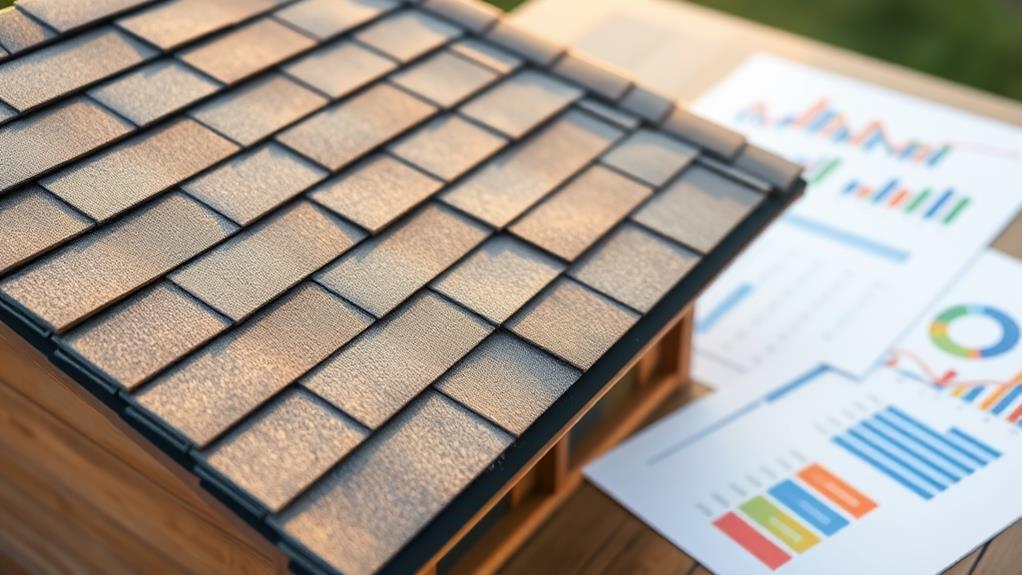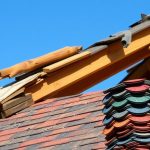Homeowner roofing insurance provides vital financial protection against unexpected events such as severe weather conditions, falling objects, or fire damage, safeguarding one of your home's most critical structural components. These policies typically account for various perils while excluding damages caused by neglect or gradual wear and tear, emphasizing the importance of regular maintenance. The insurance claim process involves detailed documentation of the damage, sometimes requiring assessments by licensed professionals and collaboration between insurers, homeowners, and contractors to verify efficient repairs. Understanding your policy's coverage limits and eligibility criteria is paramount, especially as adherence to maintenance can directly impact coverage sufficiency. Exploring further will reveal deeper insights into maximizing these benefits.
Roofing Highlights
- Homeowner roofing insurance covers damages from severe weather, falling objects, and fire.
- Policies exclude wear and tear, neglect, and certain natural acts needing separate endorsements.
- The claim process includes damage documentation, engaging adjusters, and obtaining repair estimates.
- Coverage eligibility depends on the roof's age, material standards, and adherence to maintenance requirements.
- Support includes expert advice, licensed inspections, and collaboration with local contractors.
Roofing Insurance Explained

Understanding roofing insurance requires an all-encompassing examination of its key components, starting with the specific coverage inclusions, which typically encompass repairs and replacements necessitated by common perils such as storms and hail. In areas like Colorado, homeowners often face hail and strong wind damage, which highlights the importance of safeguarding such coverage.
It is equally pivotal to be aware of policy exclusions, often including wear and tear or prior existing damage that are not covered under standard provisions. Additionally, steering through the claim process involves several precise steps, from promptly documenting the damage to coordinating with insurance adjusters to confirm a successful resolution in alignment with policy terms.
Coverage Inclusions Overview
In the multifaceted domain of homeowner's insurance, roofing coverage stands as a fundamental component, often encompassing a variety of inclusions to safeguard against potential perils. Primarily, this coverage typically considers damage caused by severe weather conditions such as hail, windstorms, and heavy snow, which can lead to significant deterioration or destruction of a roof.
Additionally, many policies extend to include protection against falling objects—such as trees or debris—that can inflict substantial harm.
Understanding these inclusions is pivotal for homeowners seeking to ensure their sanctuaries are well-fortified against the unknown. Beyond natural events, roofing insurance coverage often incorporates aspects of wear and tear, recognizing that a roof's longevity can influence the structural integrity of a home. Yet, it is indispensable to note that coverage for wear and tear is specifically delineated and may require proof of regular maintenance for claims to be valid.
Moreover, fire damage, a peril that poses severe risks to property, is conventionally covered under roofing insurance. Protection against such threats offers homeowners a cushion of security, allowing them to feel reassured in their community's continued resilience. This all-encompassing approach enables residents to feel an inherent sense of belonging through shared peace of mind.
Policy Exclusions Details
Traversing the landscape of roofing insurance requires an informed understanding of policy exclusions, which are equally as essential as inclusions. Policy exclusions define specific scenarios or conditions under which coverage is not offered, allowing homeowners to navigate the terms with precision and forethought. Often, these exclusions include damages arising from neglect, such as failing to maintain the roof adequately, which could result in water leakage or mold. Consequently, regular upkeep becomes not just a recommendation but a necessity to confirm coverage is valid.
Moreover, damages consequent to wear and tear are typically not covered, as such deterioration is considered an inescapable aspect of a roof's life cycle. Additionally, certain acts of nature, such as earthquakes, usually require separate endorsements, given their unpredictable nature and potential severity. It is imperative for policyholders to scrutinize these provisions, gaining a thorough view of what their policy encompasses and what it does not.
The alignment of expectations with reality assists in the avoidance of potential disputes during critical moments. In understanding these nuances, homeowners bond over shared knowledge, reinforcing their sense of belonging in a community of informed and proactive individuals.
Claim Process Steps
Filing a roofing insurance claim is a structured process that requires careful attention to detail to guarantee a smooth resolution. Understanding and maneuvering this process not only fosters a sense of community among homeowners but also safeguards that one's property is defended with due diligence.
Initially, homeowners should promptly assess and document any damage through photographs and written descriptions, capturing specifics that will support their claim. This documentation becomes the cornerstone of the claim, validating the extent of damage.
Contact your insurance company to report the damage as soon as possible; swift communication helps to set the claims process in motion efficiently. The insurer will often dispatch an adjuster to evaluate the roof in person, gauging repair needs and costs. It is essential to engage qualified roofing professionals who can provide reliable assessments and detailed repair estimates. Present these estimates to your insurer to align on repair scope and costs.
Once an agreement is reached on the settlement, repairs can commence, often involving collaborative discussions between the insurer, the homeowner, and contractors. Throughout this process, thorough record-keeping, proactive follow-up, and clear communication with all parties can greatly enhance the chances of a satisfactory outcome.
Benefits

Homeowner roofing insurance offers a significant financial protection advantage by safeguarding against unexpected expenses related to roofing damage, which can often be substantial. Having this insurance is particularly beneficial when dealing with storm damage types such as hail storms, high-wind storms, and winter storms that could lead to costly repairs.
Additionally, this type of insurance provides coverage for repairs, ensuring that homeowners can address issues promptly and effectively without suffering financial strain. Ultimately, the broad, all-encompassing coverage leads to peace of mind for homeowners, knowing they are protected against the uncertainties of roof maintenance and repair.
Financial Protection Advantage
Peace of mind is one of the most valuable intangible assets that a roofing insurance policy provides to homeowners. This financial safeguard is vital in protecting against unexpected outlays that could potentially disrupt personal financial stability. Homeowner roofing insurance elevates this sense of security by offering a robust financial protection advantage that directly ties way to fulfill a fundamental human need — the need to feel secure and protected within one's community and domicile.
By investing in an extensive roofing insurance policy, homeowners are financially shielded against the volatile and often unpredictable challenges that Mother Nature or unforeseen accidents may bring. This protection extends beyond the immediate repair costs, incorporating considerations such as potential property depreciation and the resulting effect on personal net worth.
Members of communities with strong ties often unite over values of security, resilience, and preparedness, and roofing insurance affords these compelling assurances. By understanding the full scope of financial protection, policyholders are not just purchasing coverage but are integrating themselves into a support network that upholds and enhances collective household stability. In this way, roofing insurance represents a proactive decision, simultaneously protecting personal wealth and fostering a greater sense of communal belonging.
Coverage for Repairs
When considering roofing insurance, the benefits of extensive coverage for repairs play a crucial role in providing financial solace. Homeowners are acutely aware of the unpredictable impact of weather patterns and time, which can intensely wear down their roofs.
This coverage assures individuals of timely and efficient repair interventions without the heavy financial burdens that normally follow significant damage. The sense of belonging to a safeguarded community is fortified, knowing that one's home, perhaps the most important investment, is well protected.
Roofing insurance that offers detailed coverage for repairs envelops a broad ambit of potential issues, including minor leaks caused by severe weather conditions or deterioration that commonly affects shingles. The inclusion of labor costs further enhances its value, ensuring that every stage of repair — from inspection, material acquisition, to skilled labor — is extensively addressed.
This empowers homeowners to maintain the structural integrity and aesthetic appeal of their residences. Moreover, such extensive repair coverages echo the commitment of insurers to uphold community standards and support homeowners in preserving their neighborhood's value.
Peace of Mind
The assurance of extensive roofing insurance extends beyond mere financial protection, offering homeowners significant peace of mind. This sense of security stems from knowing that one's home, a cornerstone of family life, is safeguarded against unforeseen damages that can disrupt daily routines and financial stability. With all-encompassing coverage, homeowners can confidently navigate the complexities of unexpected roof repairs or replacements, knowing assistance is readily available, allowing them to focus on life's more enriching experiences.
Roofing insurance serves as a shield, reinforcing community belonging by easing shared concerns over storm-related damages or unforeseen incidents. For many, this sense of belonging is not merely about owning a home, but about being part of a community where collective responsibility and mutual support are embedded values.
Efficient claims processes and reliable financial backing mean that in times of weather-induced crises, homeowners can draw upon a collective support system that underscores solidarity.
Moreover, the predictability of regular premiums offers a structured approach to managing unexpected costs, reaffirming the homeowner's place within a financially savvy network. This cultivates a sense of shared resilience, ensuring that each member can rely on dependable coverage, regardless of the unpredictable nature of future events.
Coverage Eligibility Requirements

When evaluating eligibility for homeowner roofing insurance coverage, insurers often consider several indispensable factors. Remarkably, the age of the roof plays a significant role, as newer roofs typically qualify for more extensive coverage compared to older ones. Additionally, adherence to roof material standards and understanding policy coverage limits are essential for ensuring the roof protection aligns well with insurance requirements.
| Factor | Details |
|---|---|
| Age of the Roof | Newer roofs qualify for more extensive coverage. |
| Roof Material Standards | Adherence is necessary for compatibility with policies. |
| Policy Coverage Limits | Understanding these is imperative for adequate protection. |
Age of the Roof
A critical factor influencing coverage eligibility for roofing insurance is the age of the roof. Insurers often assess this aspect meticulously, as it profoundly impacts the risk assessment and potential liability involved in insuring the structure.
Typically, newer roofs present fewer risks, as they are likely to have been constructed using contemporary materials and methodologies, offering enhanced protection against environmental elements such as rain, wind, and hail. Conversely, older roofs, especially those exceeding a certain threshold, often face scrutiny due to the natural wear and tear they have endured over time.
Insurance companies frequently set specific age limits to determine eligibility and may even apply pro-rated coverage plans that adjust based on the roof's age. For instance, roofs exceeding 20 years might see diminishing coverage, as their durability becomes more uncertain, potentially requiring homeowners to provide evidence of regular maintenance or updated inspections to qualify for full coverage options.
Belonging to a community of informed homeowners means understanding these nuances helps make prudent decisions about maintaining or upgrading your roof. This proactive approach is crucial, enabling you to preserve your home's integrity while securing favorable insurance terms that protect both your investment and your peace of mind.
Roof Material Standards
Roof material standards considerably influence the coverage eligibility requirements set by insurance providers. These standards are crucial as they guarantee homeowners utilize materials capable of withstanding various weather conditions, thus minimizing risk and potential claims. Insurance companies prefer materials such as asphalt shingles, metal, and slate due to their proven durability and resistance to environmental elements. By investing in these quality materials, homeowners not only enhance the longevity of their roofs but also make themselves eligible for more thorough insurance coverage.
In setting material standards, insurers often collaborate with industry experts to identify materials that provide optimum protection. This collaborative approach reassures homeowners that their investments meet established safety and performance criteria. Consequently, this knowledge fosters a sense of inclusion, as homeowners recognize their shared commitment with insurers to safeguard homes using standard-compliant materials.
Moreover, adherence to these standards can sometimes result in reduced premium costs, as a well-protected roof equates to a lower probability of filing insurance claims. Understanding these material prerequisites allows homeowners to make informed decisions, aligning their roofing choices with both personal preferences and insurance eligibility advantages. Ultimately, this knowledge nurtures community trust, intertwining responsible roofing decisions with shared financial security benefits.
Policy Coverage Limits
Insurance policy coverage limits play an essential role in defining the extent of protection available for roofing-related claims. These limits specify the maximum amount an insurance company will pay out for a claim, shaping the level of security a homeowner is entitled to during unforeseen roofing issues. Understanding these limits is crucial for homeowners seeking assurance that their assets are adequately safeguarded.
Coverage limits vary considerably across insurance policies, often influenced by factors such as the roofing material, age, and construction type, which insurers assess to gauge risk levels. It is important to recognize that policy limits may not cover the full cost of repair or replacement in certain circumstances, leaving gaps that homeowners need to address.
Moreover, policy coverage limits are closely linked to coverage eligibility requirements that dictate whether homeowners qualify for specific coverage amounts. Insurance providers may impose conditions related to roof maintenance, requiring routine inspections and repairs to maintain superb structural integrity.
Homeowners are encouraged to engage with their insurers to fully comprehend these stipulations and assess whether higher coverage limits are necessary, especially for roofs exposed to severe weather conditions. Ultimately, grasping the nuances of coverage limits fosters a sense of preparedness and community among policyholders, empowering them to make informed decisions.
Connect With Us
Need assistance with your roofing insurance needs? Don't wait any longer! Call us today at (303) 306-8384 for expert advice and thorough solutions.
Our dedicated team is ready to help protect your home and guarantee peace of mind. Connect with us now and let's get started on safeguarding what matters most to you!
Roofing FAQ
How Does Filing a Roofing Insurance Claim Affect Future Premiums?
Filing a roofing insurance claim may impact future premiums, as insurers might perceive increased risk. Engagement with insurance providers and understanding policy terms can help mitigate potential premium hikes while fostering a sense of collective trust and security.
Can I Choose My Own Contractor for Roof Repairs?
Yes, choosing your contractor for roof repairs is generally possible, fostering trust and community engagement. However, it is essential to verify that your insurance provider approves the contractor, ensuring compliance with policy stipulations for a seamless process.
Does Homeowner's Insurance Cover Roof Leaks Due to Poor Maintenance?
Homeowner's insurance typically does not cover roof leaks attributed to poor maintenance, as policies usually exclude damage resulting from negligence. Regular maintenance is vital for eligibility, ensuring peace of mind and community belonging within insured homeowners.
How Long Does the Claims Process Typically Take?
The duration of a claims process varies based on multiple factors, such as the complexity of the claim and the insurance provider's efficiency. Generally, it may take anywhere from a few weeks to a couple of months.
What Steps Can I Take to Prevent Roof Damage and Lower Risks?
To prevent roof damage, regularly inspect for wear and debris. Guarantee proper drainage, trim overhanging branches, and address repairs promptly. Engaging in proactive maintenance fosters a sense of security and community trust, ultimately reducing risk.




